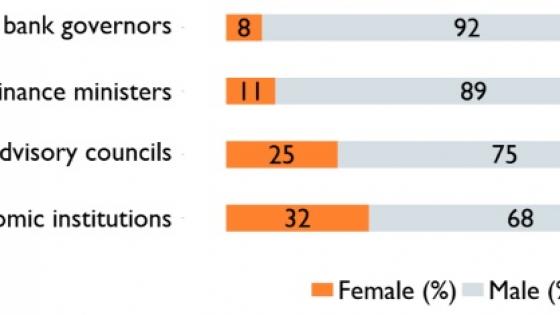Over the past two decades, the proportion of women graduating in economics in a variety of countries has either decreased or remained stagnant. In the US, Lundberg and Stearns (2019) show that, between 1998 and 2017, the female share of senior economics majors has remained between 30% and 35%. In our recent paper (Megalokonomou et al. 2021), we show that in European countries during 2013-2018, on average, 38% of economics undergraduate students were women.
We examine cross-country differences in the underrepresentation of women in undergraduate economic degrees in Europe using detailed Eurostat data on the total number of graduates by gender, degree, country for years 2014-2018. We focus on 25 countries1 for which data are homogeneous and available for most of the period of study.
Because in recent decades women are more likely to pursue a university degree than men, we rely on a within-country conversion rate based on the relative share of women enrolled in a particular field versus the total share of women graduating in the same country (Avilova and Goldin 2018). This conversion rate allows us to abstract from the possibility that women might be overrepresented in a particular field simply because there are more women attending university than men in most European countries.
Our cross-country analysis of the Eurostat dataset reveals an interesting spatial pattern. Several Eastern European countries have proportionally more women graduating in economics than men (conversion rate greater than 1), even when accounting for differences in university graduation rates between genders. Meanwhile, Northern European countries, which have achieved high levels of female representation at university as a whole, perform rather poorly and have a gender gap in graduation rates from economics undergraduate degrees.
Figure 1 Women to men conversion rate for economics graduates across Europe, 2015-2018
Notes: The ratio of the number of women to the number of men is denoted by W/M. The W/M conversion rate for economics graduates is found by taking the ratio of W/M graduating from economics over W/M graduating from university. These conversion rates indicate what the ratio of women to men would be if overall university populations had an equal number of each gender.
Next, we compare economics with its closest alternative, business studies, and STEM, a group of degrees with even more historically pronounced underrepresentation of women. Specifically, we compare the average of economics, STEM and business conversion rates2 (weighted by the number of graduates for each country in a particular year) for the countries in our sample during 2013-2018 together with the ratio of total women to men university graduates.
Figure 2 shows that, consistent with US data, during 2013-2018:
- the overall conversion rate of women versus men in economics has been stable or decreasing over time and has been around 0.6 on average (except for the UK);
- unlike economics, the conversion rate of its closest substitute, business, sits at 1.1, indicating that more women graduate than men, adjusting for total gender ratios at university; and
- the average conversion rate in STEM is worse than economics, at 0.35, but is experiencing a mild increase over the period.
Figure 2 Conversion rates in economics, STEM, and business graduates in Europe
Notes: The ratio of the number of women to the number of men is denoted by W/M. The W/M conversion rate for economics graduates, for example, is found by taking the ratio of W/M graduating from economics over W/M graduating from university. These conversion rates indicate what the ratio of women to men would be if overall university populations had an equal number of each gender.
The gender imbalance worsens as we move up the professional academic ladder (Hanspach et al. 2021). According to a recent study, in the US, women economists are 15% less likely to become associate professors than men, even after controlling for publications, citations, and grants (Auriol et al. 2019). The authors found no such gender gap in statistics, physical sciences, or engineering.
This pattern is not much different in Europe. According to this study, from more than 40% of women at entry-level research positions, the share of women falls to 22% at the level of full professor. In Australia, according to the data compiled by the Economic Society of Australia (Cassells et al. 2021), only 12% of economics professors in 2016 were women.
Women are not the only group underrepresented in economics. The field of economics is becoming less popular among students from a low socioeconomic status and other minorities. For example, in Australia, the share of enrolments of poor students or from regional areas (as opposed to major cities) studying economics in high school has halved over the past 30 years (Reserve Bank of Australia 2020).
Would more women economists make a difference?
Economics presents itself as a discipline that uses objective mathematics and data analysis in which gender should not matter. However, women can make a difference in the selection of issues economists examine and their policy recommendations.
For example, men dominate the subfield of macroeconomics, which studies the behaviour and performance of an economy as a whole. Women are more likely to become an expert in areas such as economics of labour markets, health and education (Chari and Goldsmith-Pinkham 2017).
These gender differences in field specialisation may stem from differences in academic performance across subfields, emerging as early as at the undergraduate level (Beneito et al. 2021). In particular, male students outperform female students in macroeconomic courses, while the opposite is true for microeconomics, which focuses more on the study of individual decisions of consumers, government, and firms.
Gender differences in perspectives are also evident in policy recommendations. A 2014 survey of 1,058 economists in European universities found that, on a scale from 1 to 5 where 1 indicated strongly agree and 5 strongly disagree, the average difference in women’s and men’s views was almost 2 opinion points (May et al. 2018). Women economists were more likely to support government intervention and environmental regulation and be concerned about inequality.
Similarly, a 2018 survey of US economists found that women economists were 18% more likely to agree that income should be distributed more equally and 16% more likely to agree that policies excessively favoured economic growth over environmental quality (May et al. 2014).
Why should we care?
Economics has one of the broadest presences in a range of occupations and industries, from business to government, health, and finance, and, more importantly, among those taking decisions that affect all of us as citizens and consumers. Therefore, having more women economists informing decision-making could affect how policies are designed, as the aforementioned US and European studies indicate.
Moreover, women economists can bring innovative perspectives to influence the economic discourse. For instance, Esther Duflo, Stephanie Kelton, Mariana Mazzucato, Carlota Perez and Kate Raworth are revolutionising economics by questioning and redefining the conventional understanding of economics concepts such as ‘value’, ‘debt’, ‘growth’, and ‘GDP’.
Increased representation of women economists could lead to more balanced policy recommendations for pressing issues such as climate change. Economists differ in their views about environmental policies by gender (May et al. 2021). In particular, women are more supportive of environmental intervention and protection, sensitive to social and environmental impacts, and likely to endorse action to protect the environment compared to men.
And despite COVID-19 having widened the labour force gender gap, only 13% of the 2,280 COVID-19 fiscal, social protection, and labour market measures across 219 countries have targeted women’s economic security (UNDP 2021). This potentially could have been improved for women if more women economists were advising policymakers or decision committees.
How to achieve a more gender-balanced profession?
Factors such as implicit bias in the evaluation of merit contribute to the stalled progress in women’s representation in the economics profession (Lundberg and Stearns 2019).
A 2019 Australian survey of 4,698 high school students in Years 10-12 in New South Wales shows that there is lower confidence among women and students from low socioeconomic status backgrounds (Reserve Bank of Australia 2020). Both groups were less likely to “feel they could do well in economics” and “have a clear idea of how good they would be in economics”.
A Greek study shows that an increase in teachers’ bias (more pro-boy behaviour) has a positive effect on boys’ and a negative effect on girls’ performance in the university admissions exams (Lavy and Megalokonomou 2019). This suggests that tackling teacher biases in high schools could increase women students’ performance in economics and make them more likely to enrol in a high-return university degree linked with a high-pay occupation.
Finally, role models can also make a difference. In the US, women university students exposed to successful and charismatic women who majored in economics at the same university are almost twice as likely to major in economics and experience higher earnings in the labour market (Porter and Serra 2020).
References
Auriol, E, Friebel G, and S Wilhelm (2019), “Women in European economics”, VoxEU.org, 19 November.
Avilova, T, and C Goldin (2018), “What can UWE do for economics?”, AEA Papers and Proceedings 108: 186-90.
Beneito, P, J E Boscá, J Ferri and M García (2021), “Gender imbalance across subfields in economics: When does it start?”, Journal of Human Capital 15(3).
Cassells, R, L Risse, D Wood and D Yengin (2021), “Lifting diversity and inclusion in economics: How the Australian Women in Economics Network put the evidence into action”, presented at the US Federal Reserve Board Conference on Diversity and Inclusion in Economics, Finance, and Central Banking 2021.
Chari, A, and P Goldsmith-Pinkham (2017), “Gender representation in economics across topics and time: Evidence from the NBER summer institute”, NBER Working Paper w23953.
Hanspach, P, V Sondergeld and J Palka (2021), “Few top positions in economics are held by women”, VoxEU.org, 17 August.
Lavy, V, and R Megalokonomou (2019), “Persistency in teachers’ grading bias and effects on longer-term outcomes: University admissions exams and choice of field of study”, NBER Working Paper 26021.
Lundberg, S, and J Stearns (2019), “Women in economics: Stalled progress”, Journal of Economic Perspectives 33(1): 3-22.
May, A M, M G McGarvey and D Kucera (2018), “Gender and European economic policy: A survey of the views of European economists on contemporary economic policy”, Kyklos 71(1): 162-83.
May, A M, M G McGarvey, C R Gustafson and T Mieno (2021), “Gender, environmental issues and policy: An examination of the views of male and female economists”, Ecological Economics 182: 106877.
May, A M, M G McGarvey and R Whaples (2014), “Are disagreements among male and female economists marginal at best?: A survey of AEA members and their views on economics and economic policy”, Contemporary Economic Policy 32(1): 111-32.
Megalokonomou, R, M Vidal-Fernandez and D Yengin (2021), “Underrepresentation of women in economic degrees in Europe: A comparison with STEM and business”, IZA Policy Paper 175.
Porter, C, and D Serra (2020), “Gender differences in the choice of major: The importance of female role models”, American Economic Journal: Applied Economics 12(3): 226-54.
Reserve Bank of Australia (2020), “Why study (or not study) economics? A survey of high school students”.
UNDP - United Nations Development Programme (2021), “Women’s absence from COVID-19 task forces will perpetuate gender divide, says UNDP, UN Women”, UN Report, 22 March.
Endnotes
1 This group includes countries with significant-sized economics undergraduate programmes (graduating at least 50 students each year) that have reported detailed ISCED field data for at least three of the past four years via Eurostat.
2 We use W/M to denote the ratio of the number of women to the number of men. W/M Conversion Rate for Economics Graduates is found by taking the ratio of W/M graduating from economics over W/M graduating from university. These conversion rates statistics indicate what the ratio of women to men would be if overall university populations had equal number of each gender.








